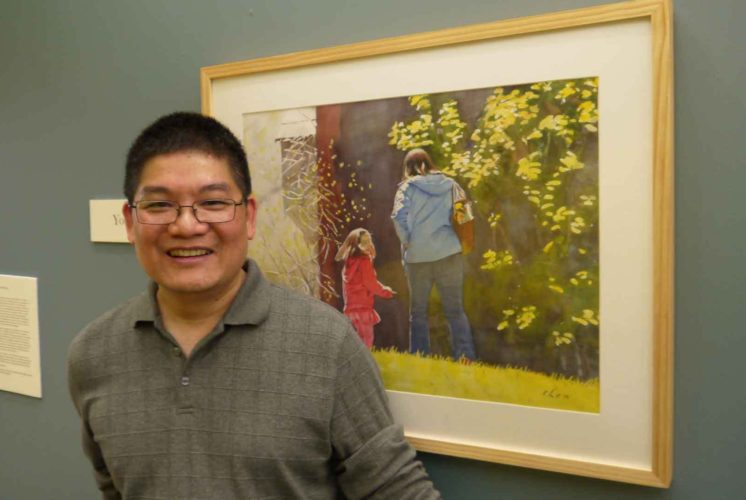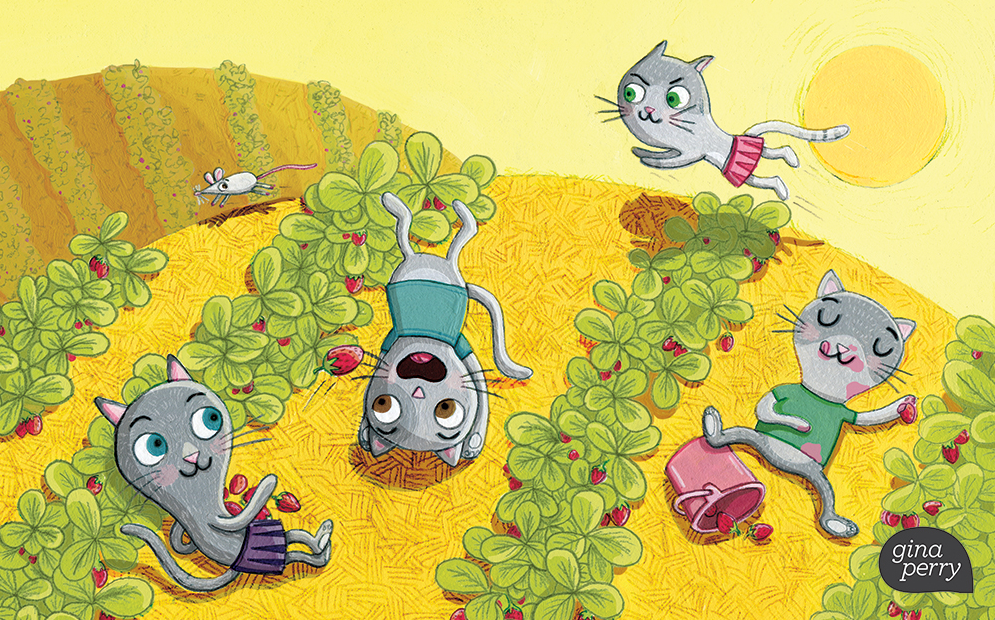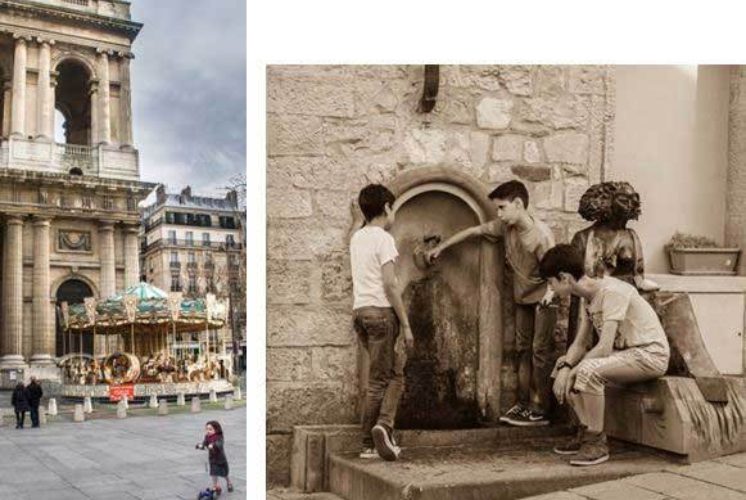Dover Mini Maker Faire Showcases Local DIY
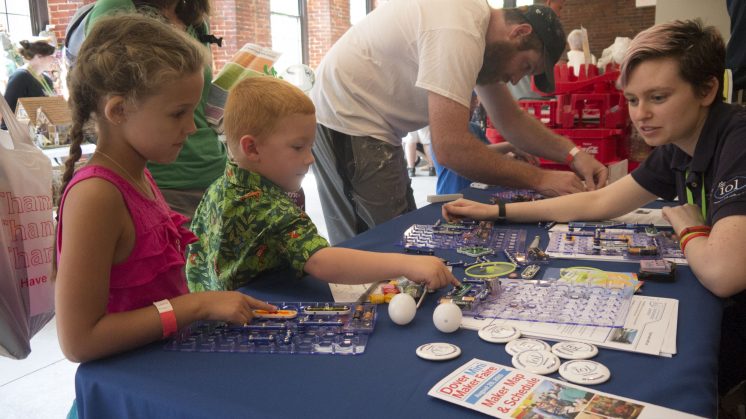
On Saturday, August 27, 2016, “Makers” and fans of the “Do-It-Yourself” movement will descend upon Dover for the Dover Mini Maker Faire. The Faire is NH’s only licensed Maker Faire and will feature 63 Makers and 8 food vendors representing 37 different towns around New England!
This hands-on festival offers people who make things, whether its fly fishing ties, or 3D printed robots, a chance to show off what they are making and share what they are learning. “The Makers are the stars of this festival,” says Jane Bard, President of the Children’s Museum of New Hampshire, organizers of the Faire. “People come to the Dover Mini Maker Faire to learn new things and to get inspired. I can’t think of any other Faire where you can see a short film, play with clay, and legos and circuits and electricity and then top it off with challenging a stormtrooper to a game of giant jenga!”
The Faire, which takes place from 10am-4pm at the Children’s Museum of New Hampshire, Henry Law Park and One Washington Mill in Dover, is always scheduled the last weekend of the summer. “We think it’s a great way to send kids back to school inspired,” shared Jane. Although, kids are not the only ones who will enjoy this Faire. “Over half the people who visit the Faire come without kids, which tells us there’s a lot of interest in the local maker movement from adults.”
New this year will be the Faire’s first short “Short Film Festival” featuring two short films and an excerpt of a longer film, all created by local filmmakers.
Father-and-daughter filmmakers Alfred Thomas Catalfo and Gina Catalfo Nelson of Dover will present two of their award-winning short films.
"Signing" is an 11-minute film written, directed and edited by Gina Catalfo Nelson. It is a heartwarming, teenage love story about trust and accepting others for exactly who they are. "Rocketship" is a 15-minute film written and directed by Alfred Thomas Catalfo in which an unlikely bond is forged between a lonely boy and an elderly man claiming to be a former astronaut. Together, they transform a vintage vacuum cleaner into a rocketship for a surprising journey. The film is inspired by the rocketship sculptures of local artist David Random. This will be the first time Alfred and Gina have shown their films together.
The other film is an excerpt from “The Man Who Wasn’t Tex Magru” a 1940’s gangster comedy by Manchester-based filmmakers Narrow Street Films. Narrow Street Films’ stunt team will also be on hand at the Faire for a film stunt workshop. The films’ Directors will be on hand for a Q&A session after the viewing.
Volunteers are still needed to help with this year’s Dover Mini Maker Faire. Volunteers who sign up for at least one 3-hour shift will receive free admission to the Faire. All volunteers must be 16 years or older.
Tickets to the Dover Mini Maker Faire are on sale now for $10. Tickets will cost $12 at the door and kids ages 5 and under are free. Purchase tickets, learn more or sign up to volunteer at www.makerfairedover.com.
The Dover Mini Maker Faire is sponsored by the Unique College Savings Plan by Fidelity, VELCRO® Brand, Alexander Technology Group, Prime Buchholz, Beswick Engineering, The Rowley Agency, Construction Services of New Hampshire, Albany Engineered Composites, Chinburg Properties, Holy Rosary Credit Union, Garrison Women’s Health, Coed Sportswear, Inc. and Leone, McDonnell & Roberts, PA. Media sponsorships have been provided by iHeart Media, 95.3 The Bull, Z107, NH1 News on WBIN TV and New Hampshire Public Television.
Parking and Directions
What an absolutely boring topic for a blog! Parking?! Directions!? Meh.
However, it seems to be a thing preventing many of you from coming to visit us! So let's address some of the misconceptions about parking at and navigating to the Children's Museum of NH.
Misconception #1: No free parking
All city parking is free on the weekends and after 7pm. As an amenity to our guests we sell the city of Dover's pre-packaged bags of 26 parking tokens for $5 at no mark-up. They are for sale at the front desk during normal business hours as available. That will give you about a 30% savings off the current rate. You can also purchase these tokens at Harvey's Bakery and the Dover Chamber of Commerce.
Misconception #2: Metered parking spots have a time limit
The metered spots along Henry Law Avenue, as well as the spots inside the Dover playground parking lot do not have a time limit. You can get a parking receipt for ANY length of time up to 7pm...at which point, parking is free! Metered spots cost $1/hour and accept change or credit cards.
Misconception #3: Not enough parking
We beg to differ! In addition to all the "pay and display" spots in the parking lot, on-street spots along Henry Law Ave, Central Ave, Washington Street and Main Street there are also metered spots in Dover's new 300+ space downtown parking garage at 45 Orchard Street, which is only a 5 minute walk to the museum! This new (opened in 2016) garage has a Pay by Space system and costs $0.75 an hour. You can actually download an app that will allow you to pay for more time remotely without having to return to the garage. Learn more about it here.
Misconception #4: Getting there is confusing!
Well, we'll admit to this one. Downtown Dover can be a bit confusing to navigate on your first trip. We've tried to make it easier with the handy map below. There are a couple of things to keep in mind. One, put in 10 Henry Law Ave into your GPS, not our mailing address, 6 Washington Street. This will put you on the right road to find the parking lot!
The second thing to keep in mind is that Washington Street, Main Street and Henry Law Ave are all one way. No matter which way you are coming from, North, South, East or West, if you get to downtown Dover and pass by the museum (in pink), you can just follow the yellow triangle around and try it again till you make it to the parking lot (orange).
Let's break it down by direction:
If you are coming up Central Ave (otherwise known as Rte. 9 or 108) and get to the Central Ave/Washington Street lights, take a hard right onto Henry Law Ave. (OR, avoid the light altogether and just past the bus stop across from City Hall, take a right onto Williams Street which will take you right onto Henry Law Ave. Your next left takes you into the parking lot behind the museum!)
If you are coming down Central Ave (otherwise known as Rte. 9 or 108), stay in the left hand lane but don't take a hard left. Take the soft left, across Washington Street onto Henry Law Ave.
If you are coming down Washington Street, stay in the right lane, but don't take a hard right onto Central Ave, take a soft right onto Henry Law Ave past the intersection.
If you are coming from Portland Ave, you have to take a right onto Main Street. Take your first left and swing around onto Central Ave (otherwise known as Rte. 9 or 108). Then stay in the left hand lane but don't take a hard left. Take the soft left, across Washington Street, onto Henry Law Ave.
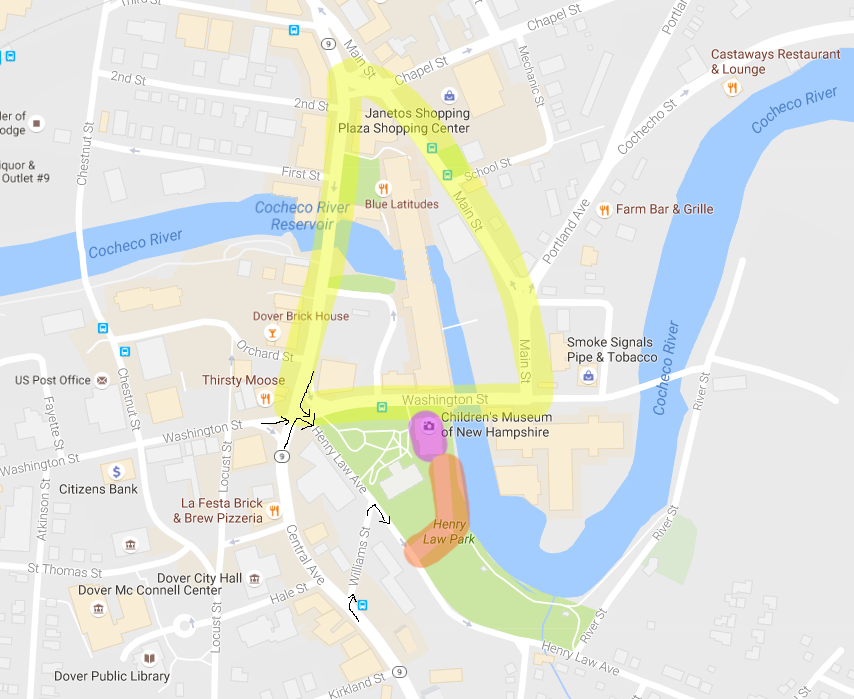
Here's a closeup of the intersection that seems to give people the most trouble.

And of course if you get lost, just give us a call: 603-742-2002. We'll talk you through it!
NH’s only Maker Faire will be held in Dover

The fourth annual Dover Mini Maker Faire, taking place on Saturday, August 27, 2016 and organized by the Children’s Museum of New Hampshire, is New Hampshire’s only licensed Maker Faire. But, what exactly is a Maker Faire? “It’s a question we get asked a lot,” laughs Children’s Museum of New Hampshire President Jane Bard. “It’s a hands-on festival for all ages. Faire-goers get to see what the creative and innovative people and businesses (also known as Makers) in their communities are making and creating, and the Makers who choose to participate in the Faire get to show off their knowledge! And all of our Makers offers a unique activity or workshop for people to try out.”
The Dover Mini Maker Faire is designed to be forward-looking, showcasing makers who are exploring new forms and new technologies. But it doesn’t just highlight the technical fields. Maker Faires, in general, also feature innovation and experimentation across the spectrum of science, engineering, art, performance and craft. So it’s not unlikely to see a young baker showcasing her cupcake recipes next to a high-tech personal transportation device from Segway at a Faire…both of which you can see at this year’s Dover Mini Maker Faire.
At the Dover Mini Maker Faire, which takes place inside the Children’s Museum of New Hampshire, outside in Henry Law Park and across the river at One Washington Mills, people can make and launch a paper rocket, find out how to publish a book, learn about beekeeping, drive a robot, learn how to code, eat ice cream made using liquid nitrogen, take a selfie with a Stormtrooper, explore electricity and make a working circuit, try their hand at movie stunt fights, learn about the science of brewing and so much more. “People really are amazed at just how much there is to do at the Faire,” said Jane. “In fact, I think we figured out that to see everything at the Faire you’d have to spend only 6 minutes at each Maker booth!”
This year’s Faire has the most Makers signed up to participate, as well as the most food vendors, since it started four years ago. “We’re pretty excited about all the Makers of course,” said Jane “But I’m also looking forward to trying food from all our food trucks!” Newcomers to the Faire, Boogalows Island BBQ, Vagabond Coffee, Sub Zero Ice Cream and People’s Popcorn will join alumni Terra Cotta Pasta, Kona Ice and 7th Settlement Brewery’s “Juice Burger” truck. In the spirit of the Maker Movement, many of these food vendors are “Do-It-Yourselfers.” “Sub Zero Ice Cream will be doing an on stage science experiment with nitrogen, 7th Settlement Brewery will be giving tours of their micro brewery which is right across the street from the museum, and Vagabond Coffee made much of their setup at Port City Makerspace…who is also represented at this year’s Faire” said Jane.
2016 marks the 4th annual Dover Mini Maker Faire. The Faire is a licensed event through Maker Media. The first Maker Faire was hosted in the Bay Area of California in 2006 as a place for makers to show what they made and share what they learned. In 2013, 100 independently-produced Mini (one day events) and Featured (2 or more day events) occurred around the World. In fact, this year’s Dover Mini Maker Faire is scheduled on the weekend between Calgary, Canada and Berlin, Germany Faires.
Volunteers are still needed to help with this year’s Dover Mini Maker Faire. Volunteers who sign up for at least one 3-hour shift will receive free admission to the Faire. All volunteers must be 16 years or older.
Tickets to the Dover Mini Maker Faire are on sale now for $10. Tickets will cost $12 at the door and kids ages 5 and under are free. Purchase tickets, learn more or sign up to volunteer at www.makerfairedover.com.
The Dover Mini Maker Faire is sponsored by the Unique College Savings Plan by Fidelity, VELCRO® Brand, Alexander Technology Group, Prime Buchholz, Beswick Engineering, The Rowley Agency, Construction Services of New Hampshire, Albany Engineered Composites, Chinburg Properties, Holy Rosary Credit Union, Garrison Women’s Health, Coed Sportswear, Inc. and Leone, McDonnell & Roberts, PA. Media sponsorships have been provided by iHeart Media, 95.3 The Bull, Z107, NH1 News on WBIN TV and New Hampshire Public Television.
Teddy Bears (and more) get a Checkup!
Teddy Gets a Checkup at Our Teddy Bear Clinic
By: Amanda Girard, CMNH Intern
It's that time of year again! Our Teddy Bear Clinic is coming up on Friday, August 5 2016. This is one of our favorite events that we’ve been doing for over 25 years! At last year's clinic we talked to many families who have made it a tradition to come every summer. One family we talked to has actually cancelled hair appointments to go to our Clinic!
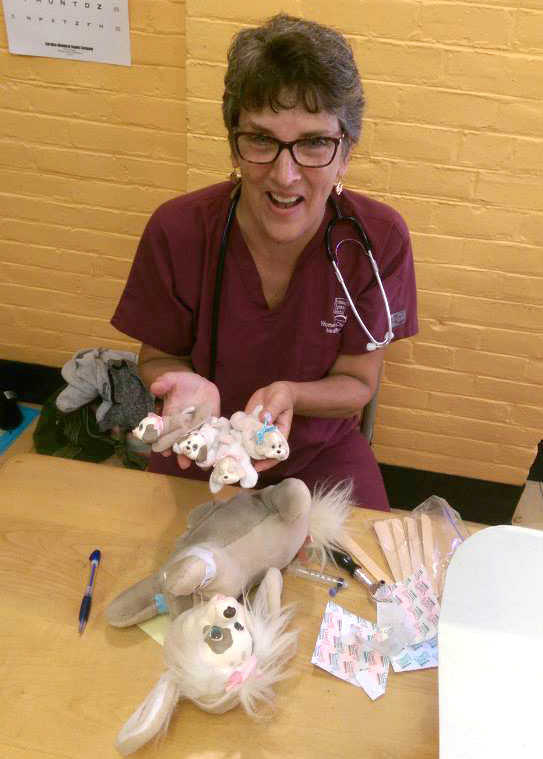 “It’s the cutest idea!” was something that I heard a lot during the last clinic as visitors checked in their patients. After getting an ID bracelet with their name on it (names ranging from "Stuffy" and "Bunny" to "Who Who" the owl and many, many others) and a short wait in the waiting room, each animal was ready to visit one of our volunteer doctors from Portsmouth Regional Hospital.
“It’s the cutest idea!” was something that I heard a lot during the last clinic as visitors checked in their patients. After getting an ID bracelet with their name on it (names ranging from "Stuffy" and "Bunny" to "Who Who" the owl and many, many others) and a short wait in the waiting room, each animal was ready to visit one of our volunteer doctors from Portsmouth Regional Hospital.
Stuffed animals were weighed and measured and some got stitches, Band-Aids and stickers too. Last year, we even had a patient named “Doggie” become a Mom to 4 puppies, a first for our clinic!
Even though it’s called a “Teddy Bear Clinic,” visitors brought more than just bears! Tigger, a giant frog,
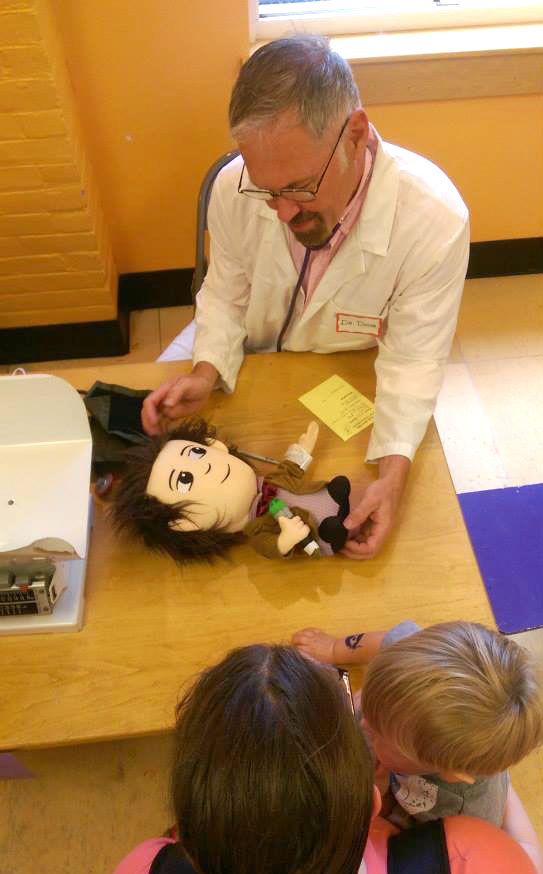
colorful birds, Clifford the Big Red Dog, a cat mermaid, Pluto, horses, unicorns, and even Dr. Who were just some of the many unique patients!
“The variety is always something that gets me,” said Zach, a Museum staff member. “I mean, there are plenty of Teddy bears, but also snakes, cats, dogs and more. Dr. Who is a first though!”
The event also helped kids who may be a bit anxious about visiting the doctor. “It makes kids more comfortable with the idea of going to the doctor,” one of our volunteer nurses explained. “Seeing that a needle doesn’t hurt Teddy can help kids who may be afraid of needles.” If their stuffed friend can make it through a trip to the doctor, then they definitely can!
Afterwards, visitors played with their dogs, Teddy Bears, cats and bunnies throughout the Museum until our Teddy Bear Picnic where everyone enjoyed juice, fresh fruit and animal crackers on a beautiful day in Henry Law Park!
We hope you can join us for this year's Teddy Bear Clinic!
Everything Under the Sun: Artist Interviews
Susan Mariano, CMNH Intern
Barbara Albert
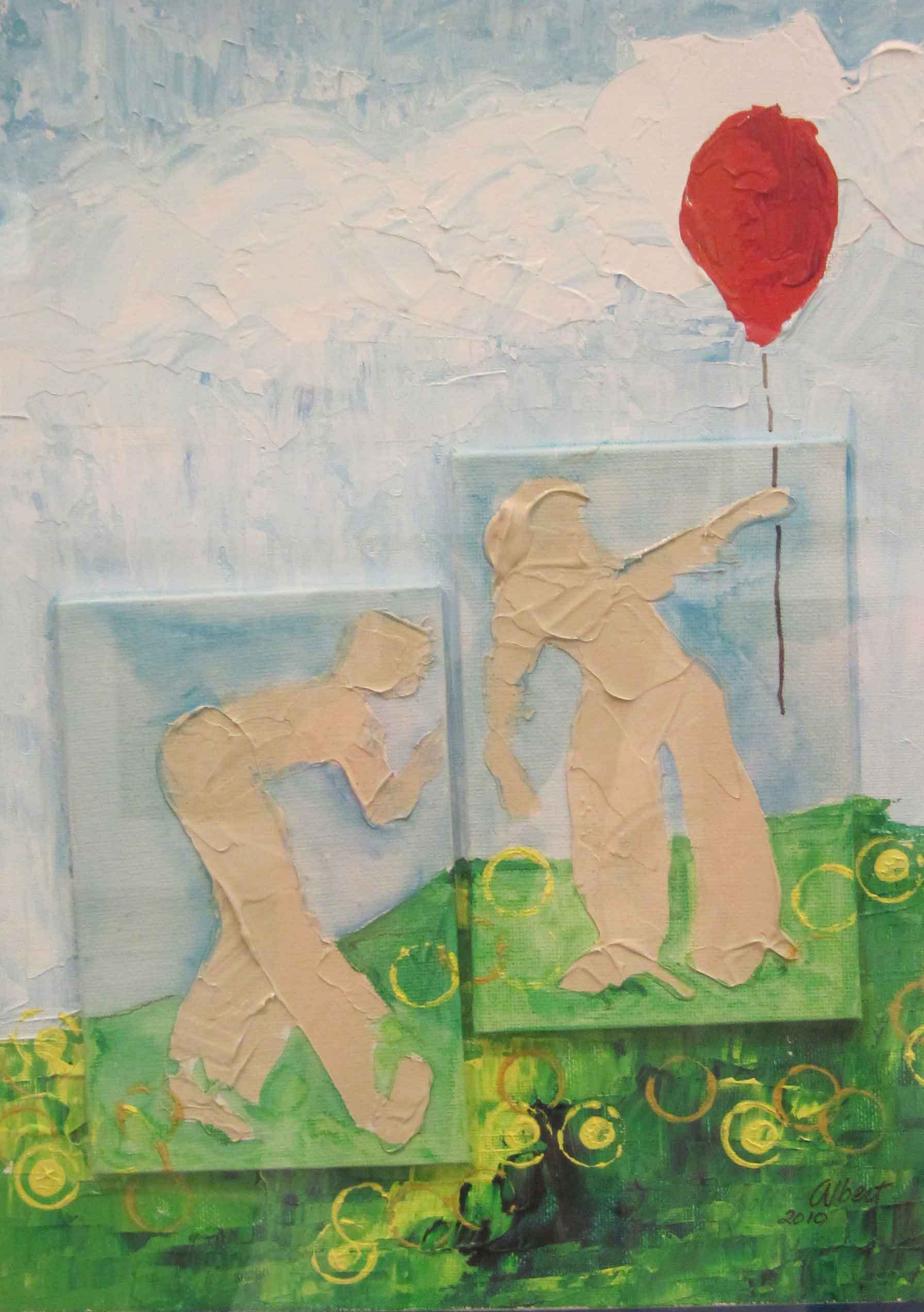
Q. Barbara, I really like the way that you have added dimension to your painting by affixing the smaller canvases of the two children on top of your hillside background canvas. The way the string of the balloon appears in the foreground and balloon itself in the background, makes it seem as though the balloon belongs to the children, yet has a separate existence of its own outside of their play.
What feeling or message are you hoping to
invoke with the viewers of “The Red Balloon”?
A. Children often struggle with sharing. My painting of two kids with a red balloon, tells a story about making choices. Look closely at the boy on the left. Does the way he is standing suggest that he wants to hold the balloon, too? You can feel the boy wanting to hold the string while the girl on the right seems unwilling to share her prize. Do you think the girl on the right will let him? Will he convince her to let it go? Will the balloon escape at first opportunity? If it was your balloon would you share it?
Yong Chen
Q. Yong, the detailed facial expressions in your paintings are very moving and being able to watch you actually paint a portrait during the artists’ reception was incredible! The watercolor paintings that you have chosen for this exhibition truly capture the emotional element of childhood play when there is not a care in the world but the moment that you are living in, and the sense of security found in spending unhurried, quality time with treasured parents.
What is it that
catches your eye and creates the desire within you to paint a particular
person?
A. Whenever I see happy children under the sun, I want to put them in my paintings, because I would feel the genuine, unselfish love from the parents. I hope that my paintings will inspire my viewers to spend more quality time with their children.
My core belief that guides my parenting is that children are happier when they're outside, in the sunshine, playing, enjoying, exploring and learning about the wonderful world they live in. I'm experiencing the same struggle as most parents do of how to balance life and work in the modern technologically obsessed environment around us. For many working parents, it is very difficult to consistently make their children the priority. In each of my watercolor paintings in this series, there is one story to tell, and behind it a very happy child. We should see the love, caring and sacrifice from the parents. As an illustrator, I am trying to use my paintings to connect the parents with their own happy childhood memories, when in those times there was not much technology, and share my thought with them that they should make time to bring their children outside and play.
Taylore Kelly

Q. Taylore, the golden circular shapes in the center of all of your mixed media artwork convey a sense of warmth and security, as they surround the delicate creatures within.
What statement are you making with the vintage printed backgrounds that you have chosen for each of your pieces?
A. I like to up-cycle the vintage pages from damaged antique books that would have otherwise found their demise and give them a new life by creating on them.
Q. Would you share your thoughts on your unique title choices?
A. Then All the Sky Which Only, the hummingbird, has the specific background because I saw the sentence, “Nature of Matter and Mind” within it and I turned it into my belief system of nature being grace, and that I do not understand, nor do I need to understand the mystery of grace. The title is simply a sing song way to say “Look what the sky holds! Hummingbirds!” Words have melody when we look and search.
By All and Deep by Deep, the whale, has a mathematical equation background because when I squinted my eyes the equations looked like music notes. Well let’s be honest I am far sighted and thought, indeed they were music notes. I love the songs whales sing. The title is because whales seem to live very deeply on all levels, figuratively, literally, musically, richly.
Whatever a Sun will Always Sing is You, the fox in the eclipse, is on a page about insanity, but the page is reversed. Tarot Cards meanings at times will be the complete opposite if inverted. Actually a lot of symbols mean the opposite when inverted. A subliminal message of how rabies seem to get these lovely creatures quite often, but not this one. She is sleeping in a soft eclipse of her own music.
Open You the Biggest and All, the deer, is in a sun nest. She is open and feels one with the Universe and what is bigger than that? I can not think of anything. She is on upside down equations as well because I thought they were music notes. Sometimes these things happen and I just flow with them!
Gina Perry
Q. Gina, I really love the way that your colorful illustrations have captured the whimsy of a child’s imagination, the details that you put into your work, and how each person and creature is sharing time with others, yet in their own little world.
What made you decide to become an illustrator?
A. My short answer is usually that a very big part of me is STILL a child, and I'm making pictures that make that part of me happy! But here is the long answer, as well. Books were a huge part of my childhood. They allowed me to see into other worlds that as a child I couldn't travel to on my own. I also loved art from a young age but never thought of illustration as a career path until I was in art school. Even then, I studied computer animation - and I think what most attracted me to that profession was the visual storytelling. Once I was working in animation, I understood how little personal vision I could put into a project and that I wasn't working with the audience I loved the most - children. I didn't put the pieces together until I was taking a children's illustration class - suddenly I knew exactly what I wanted to do! It really felt like a light deep inside me finally clicked on. I love learning, so I soaked up everything that would help me reach my goal. Over the years I took lots of classes, joined critique groups, attended conferences, read mountains of picture books, and worked incredibly hard to find a place in children's book illustration.
Q. Do the authors set “rules” for you limiting you to their vision or do you get to express what you see within your own imagination?
A. Most projects allow me to set lots of rules - from how the characters look to the size of the book itself and where the text breaks up throughout the book. Other projects come with more guidelines, usually from an editor or art director, but there is always room for my own approach and vision. Finding ideas and characters that the author didn't originally state, but that add to the story, is one of the most exciting parts of my job!
Q. What medium to you use to craft your illustrations?
A. I use a mix of gouache (opaque watercolor), soft pencils and Photoshop.
Michal Smiglowski
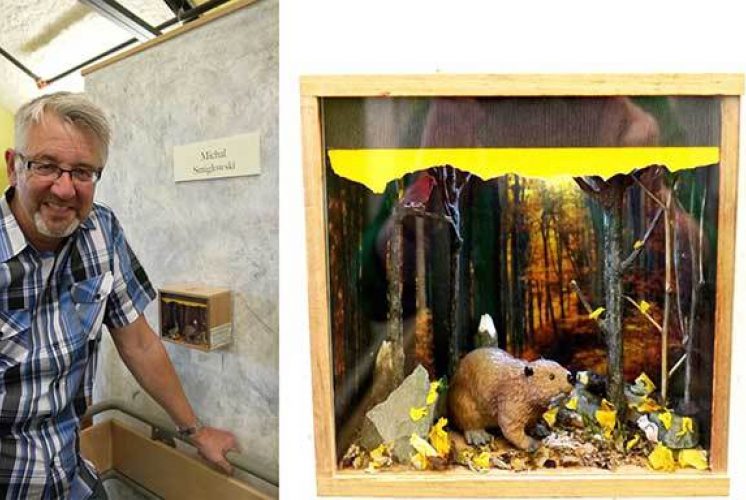
Q. Michal, you are known for drawing incredibly detailed black and white penciled portraits and illustrations. In this exhibition you have traveled in a totally different artistic direction, leading you to the creation of fascinating 3-dimensional, illuminated worlds inside of cigar boxes. In conversation you eluded to a future endeavor using yet another medium.
Please share what it is that truly inspires you to boldly go where you have not gone before.
A. On a visit to our favorite Maine 'Dowling Walsh' Gallery, located in Rockland, we came across artwork the likes I had never seen before. I was immediately fascinated by the medium, craftsmanship and story. The artist is Anne Emmanuelle Marpeau from Brittany France. The works were of dioramas of the coast, sailing and sea. I was so taken with them I got to thinking about creating something similar on a smaller scale, and so after much experimentation and development my boxes were born.
Less exacting than my pencil portraits and entirely different, I
loved the change in medium and the unending and imaginative ideas you
could create.
I am always coming up with new ideas and creative projects, adding
them to my repertoire of artworks. The part I quite enjoy is figuring
out (engineering) how these 3 dimensional projects can work, and yes, I
have yet another idea in my mind… here we
go again. It's so much fun!
In the world of hi-tech, the hand-crafted creative is both rewarding and therapeutic.
Debra Woodward
Q. Debra, I like that you selected photographs of children from France, Mexico and Italy for this exhibition as your photos serve as a reminder that the essence of being a child has no international borders. Your statement that “Photography is so much about ‘seeing’ and not just taking snapshots,“ rings so true with your photographs. As the viewer continues to gaze at one of your photos, it seems that there is more going on than just a quick glance can reveal.
Do you see these nuances as you are taking the photo or discover afterwards that they were what compelled you to capture the image?
A. Thank
you for saying that my photographs are not snapshots, but more about
seeing. That is what I strive for. As for whether capturing the
essence of being a child was intent or a lucky result of my shooting
(which I admit can absolutely happen!) on those days in Mexico, Paris
and Tuscany, I think I can fairly say that with these particular photos I
was excited to see what was happening in the world around me and sought
to capture the moment. The child in Mexico was playing with some of
the jewelry that her parents crafted and sold and I could see that she
was just so beautiful. In Tuscany, I shot many images of those boys
playing soccer but was happy that I stuck around to photograph
their camaraderie afterwards. And in Paris, I was very excited to
see that little girl on her scooter in front of the carousel. It was an
image I would never be able to capture close to home. It was so
Parisian. She reminded me of the little girl in the Madeline books!
Farewell to Mark Cuddy
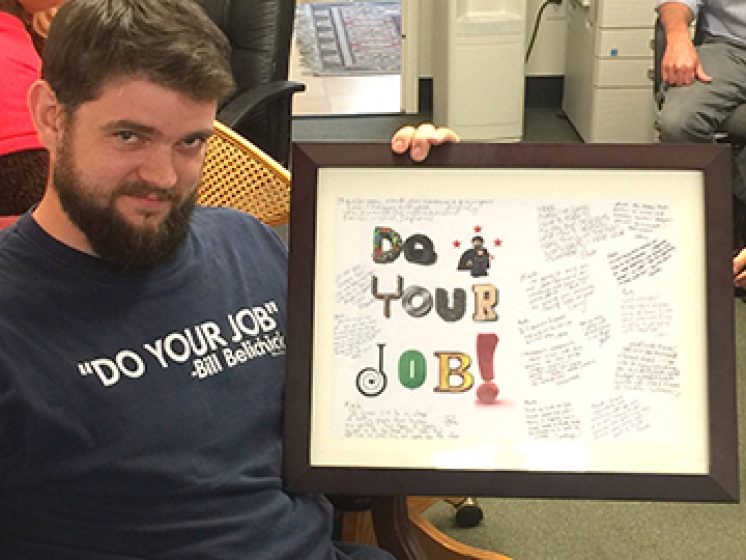
Sadly, Exhibits Director Mark Cuddy is leaving the museum after 5 years of designing and building amazing exhibits at the Children’s Museum of New Hampshire We are all very sad to see him go as he has always been a solid contributor to CMNH. I sat down with Mark and asked him to reminisce a bit on his time here at the Children’s Museum.
How long were you at the museum?
Just about 5 years.
What made you want to work at CMNH?
I was working part time at the Children's Museum in Easton and was looking for full time work at a children's museum. I saw the job opportunity here in NH, came for an interview, and really liked the museum, the exhibits and the workshop space downstairs so I applied and was lucky enough to get the job.
What are some of your typical duties as Exhibits Director?
I oversee everything that has to do with the exhibits, so it varies day to day. Some days it might be maintenance on something that broke the day before, it may be trying to re-design an exhibit component so it functions better, or it may be planning, designing or building a new exhibit.
What are you going to miss the most about your job?
I like the workshop, and I like working on the whole design process from initial ideas and concepts all the way through fabricating and installing the exhibit.
 Any cool stories about building exhibits? Setting them up? Challenges?
Any cool stories about building exhibits? Setting them up? Challenges?
I've learned a lot and had to figure a lot of things out along the way. We set up 2 temporary exhibits with K'nex called Colossal Construction, so I got to build all sorts of cool roller coasters and ball ramps. Some of them worked better than others, but it was a fun process. The roller coaster by Primary Place was supposed to be a temporary installation but it has been so popular that we have kept it for years.
Any crazy exhibit ideas that you wish you could have done but never happened?
Not really, I tried to keep our concepts and ideas to what I thought we could actually accomplish. I didn't want to suggest something super cool, but crazy, and not be able to follow through on the idea.
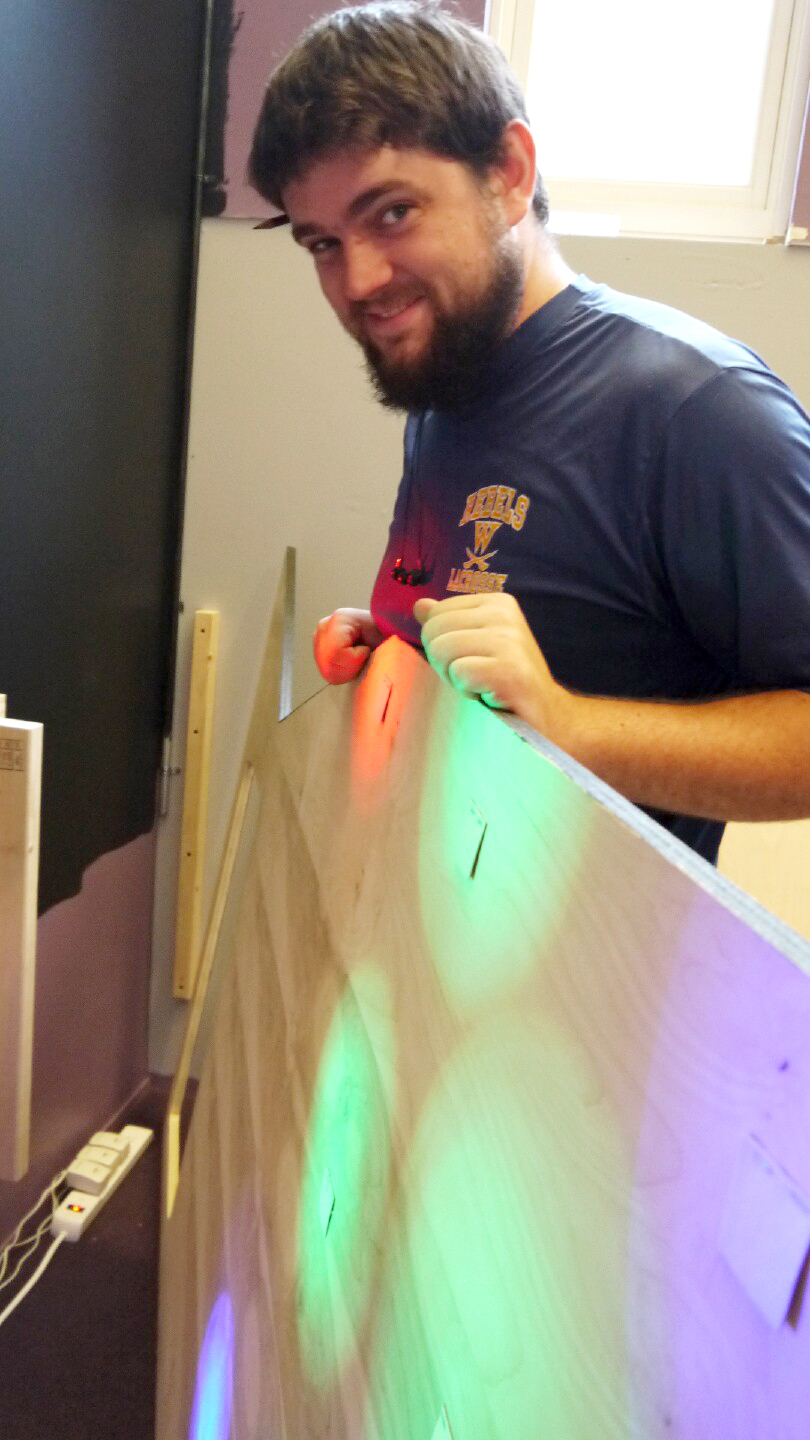 Is there an exhibit you created you are most proud of?
Is there an exhibit you created you are most proud of?
I'm not sure if I can pick just one. I like the Cave Explorers exhibit because that is a different, dark environment that provides a different experience for children and families. That was a whole exhibit that I designed and built. I also like the updates we made to the green screen exhibit, now called Adventures in Travel, because we used existing technology that we had, but were able to update and enhance the experience.
Where are you off to now?
I'm going to Garrison City Beerworks to work full time there, being a jack of all trades and assisting in the entire process of brewing, from cleaning and sanitizing, to brewing, to canning the beer, and any maintenance tasks to keep things running smoothly.
Anything you’d like to say to your co-workers or the families who visit?
To the co-workers, I know you will miss me.
We will miss you too Mark! On behalf of all the employees and guests at the children’s museum we thank you for your hard work over the last 5 years and wish you well on your exciting new opportunity at the brewery!
Finding the Summer in STEAM
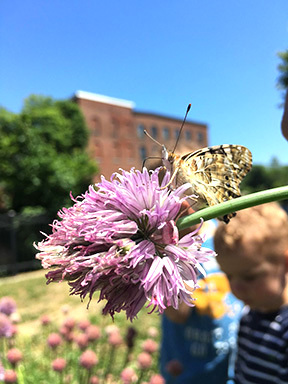 by Sarah Terry, Museum Educator
by Sarah Terry, Museum Educator
Could it finally be summer in New Hampshire? This winter child is a little sad (and hauling up the air conditioners from my basement…), but it’s hard to feel too badly when all the trees and flowers are in bloom!
I’ve been watching our museum garden start to grow out back – we have a ton of different herbs, all kinds of vegetables poking their stems up – and contemplating my unfortunate black thumb. I’ve never really been able get anything to grow except aloe plants (which apparently thrive on neglect), so I’ve been thinking a lot about the science behind growing things, the way plants and animals fit into their environments, and the effects, both positive and negative, that human beings can have on those environments.
It’s with those thoughts in mind that I’ve decided it’s high time to dirty up our fancy new STEAM Lab a bit! For the month of June, all of our lab activities are going to be focused on ecology.
I chose ecology in particular because it focuses on how all the elements of our environment work together. Ecologists look at plants, animals, soil, people – all the pieces of the puzzle. That’s what I’m hoping kids and parents will get a taste of in the lab this month.
And taste may be literal! I’m planning on growing some oyster mushrooms in the lab for kids to inspect, as well as planting some pea plants. We’ll be looking at strawberry DNA, making seed bombs, learning about beavers, making biomes in a bag, and even raising some butterflies!
We’ll be posting our STEAM Lab schedule weekly, so make sure to check our Facebook page and calendar for updates!
And who knows – maybe I’ll even get to upgrade my black thumb to something a little greener! Wish me luck!
Calling All Makers 2016
4th Annual Dover Mini Maker Faire Seeks Participants

The Dover Mini Maker Faire, New Hampshire’s only licensed Maker Faire, takes place in downtown Dover every year at the end of August and is hosted and organized by the Children’s Museum of New Hampshire. Saturday, August 27 is a day-long festival where people of all ages show what they are making, and share what they are learning. But it’s not your typical New England fair. More than 1,600 people attended last year to interact with robots, play with rockets, try their hands at science experiments, geek-out with innovative technology, create arts and crafts and so much more.
The Children’s Museum of New Hampshire is seeking Makers to participate in this year’s Faire.
“We get asked all the time, what exactly is a ‘Maker,’ and the answer is really very simple. Anyone who loves to create things with their own hands is a Maker!”
“Makers are everywhere once you start looking for them,” said Neva Cole CMNH Communications Director. “Many people might not ever even consider calling themselves makers until I point it out to them. I have friends who have normal jobs, but on the weekend they make their own soap, or build portable pizza ovens that they take to the beach! Some are stay-at-home moms who are incredible artists, or stay-at-home dads who build go-carts in their garage!” All ages are welcome to apply as Makers at the Dover Mini Maker Faire. Applications are online at www.makerfairedover.com. The deadline for Makers to apply is Friday, August 5.
The Dover Mini Maker Faire is not your typical “Ferris wheel and cotton candy” fair, although there will be incredible local food from Terra Cotta Pasta, 7th Settlement Brewery, Boogalows BBQ, Kona Ice and Clyde’s Cupcakes. This is a hands-on festival for all ages, and in the tradition of Maker Faires, celebrates the thriving resourcefulness, innovation, creativity and forward-thinking technology that can be found in New Hampshire today.
“We continue to be so impressed by the region’s creativity, and feel honored to be able to provide these makers, whether they are young or young at heart, with a venue to showcase their talents,” said Jane Bard, President of the Children’s Museum of New Hampshire.
The Dover Mini Maker Faire will take over downtown Dover, with four locations: upper and lower Henry Law Park, The Children’s Museum of New Hampshire, and One Washington Mill.
Advance tickets will be on sale July 1-31 for $10 and tickets at the gate will be $12. Children ages 5 and under are admitted free. Tickets can be purchased online at www.makerfairedover.com.
For more information on the Dover Mini Maker Faire, please call 603-742-2002 or visit www.makerfairedover.com.

